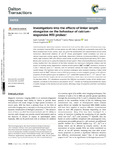Mostrar o rexistro simple do ítem
Investigations into the effects of linker length elongation on the behaviour of calcium-responsive MRI probes
| dc.contributor.author | Connah, Liam | |
| dc.contributor.author | Truffault, Vincent | |
| dc.contributor.author | Platas-Iglesias, Carlos | |
| dc.contributor.author | Angelovski, Goran | |
| dc.date.accessioned | 2019-10-17T10:01:12Z | |
| dc.date.available | 2019-10-17T10:01:12Z | |
| dc.date.issued | 2019-07-25 | |
| dc.identifier.citation | L. Connah, V. Truffault, C. Platas-Iglesias and G. Angelovski, Dalt. Trans., 2019, 48, 13546–13554. | es_ES |
| dc.identifier.issn | 1477-9226 | |
| dc.identifier.issn | 1477-9234 | |
| dc.identifier.uri | http://hdl.handle.net/2183/24142 | |
| dc.description.abstract | [Abstract] Understanding the relationship between chemical structure and the effectiveness of bioresponsive magnetic resonance imaging (MRI) contrast agents can offer help to identify key components required for the future development of such probes. Here, we report the development and characterisation of two novel monomeric bifunctional chelators, L1 and L2, whose paramagnetic metal complexes can serve as calcium-responsive contrast agents. Specifically, relaxometric titrations, luminescence lifetime measurements, high resolution NMR and diffusion experiments, as well as density functional theory (DFT) calculations were carried out to assess the behaviour of each system. Minor structural differences between the probes resulted from the extension of the linker between the macrocyclic lanthanide chelator and the acyclic Ca-binding moiety. Relaxometric titrations of both systems, GdL1 and GdL2, showed an increase in r1 and r2 relaxivity upon Ca2+ addition, with the derivative bearing the longer linker showing a greater overall change. The hydration states of the europium analogues were assessed revealing a higher initial hydration state for EuL2. Diffusion ordered NMR spectroscopy revealed negligible changes in the diffusive properties of both systems upon the addition of Ca2+, while NMR studies of the Y3+, Yb3+ and Eu3+ analogues provided further insights into the structural behaviour of the linker unit in both the unsaturated and Ca-saturated states. DFT calculations supported the different coordination modes of the studied paramagnetic complexes in the presence and absence of Ca2+. Overall, our findings demonstrate the impact of subtle changes to the structure of such probes, affecting a range of properties and their coordination behaviour. | es_ES |
| dc.description.sponsorship | German Research Foundation; AN 716/7-1 | es_ES |
| dc.language.iso | eng | es_ES |
| dc.publisher | Royal Society of Chemistry | es_ES |
| dc.relation.uri | https://www.doi.org/10.1039/C9DT02672J | es_ES |
| dc.rights | Atribución 3.0 España | es_ES |
| dc.rights.uri | http://creativecommons.org/licenses/by/3.0/es/ | * |
| dc.subject | Smart contrast agents | es_ES |
| dc.subject | Water exchange-rates | es_ES |
| dc.subject | Complexes | es_ES |
| dc.subject | Luminescence | es_ES |
| dc.subject | Europium | es_ES |
| dc.title | Investigations into the effects of linker length elongation on the behaviour of calcium-responsive MRI probes | es_ES |
| dc.type | info:eu-repo/semantics/article | es_ES |
| dc.rights.access | info:eu-repo/semantics/openAccess | es_ES |
| UDC.journalTitle | Dalton Transactions | es_ES |
| UDC.volume | 48 | es_ES |
| UDC.issue | 36 | es_ES |
| UDC.startPage | 13546 | es_ES |
| UDC.endPage | 13554 | es_ES |
Ficheiros no ítem
Este ítem aparece na(s) seguinte(s) colección(s)
-
GI-REACT! - Artigos [113]






